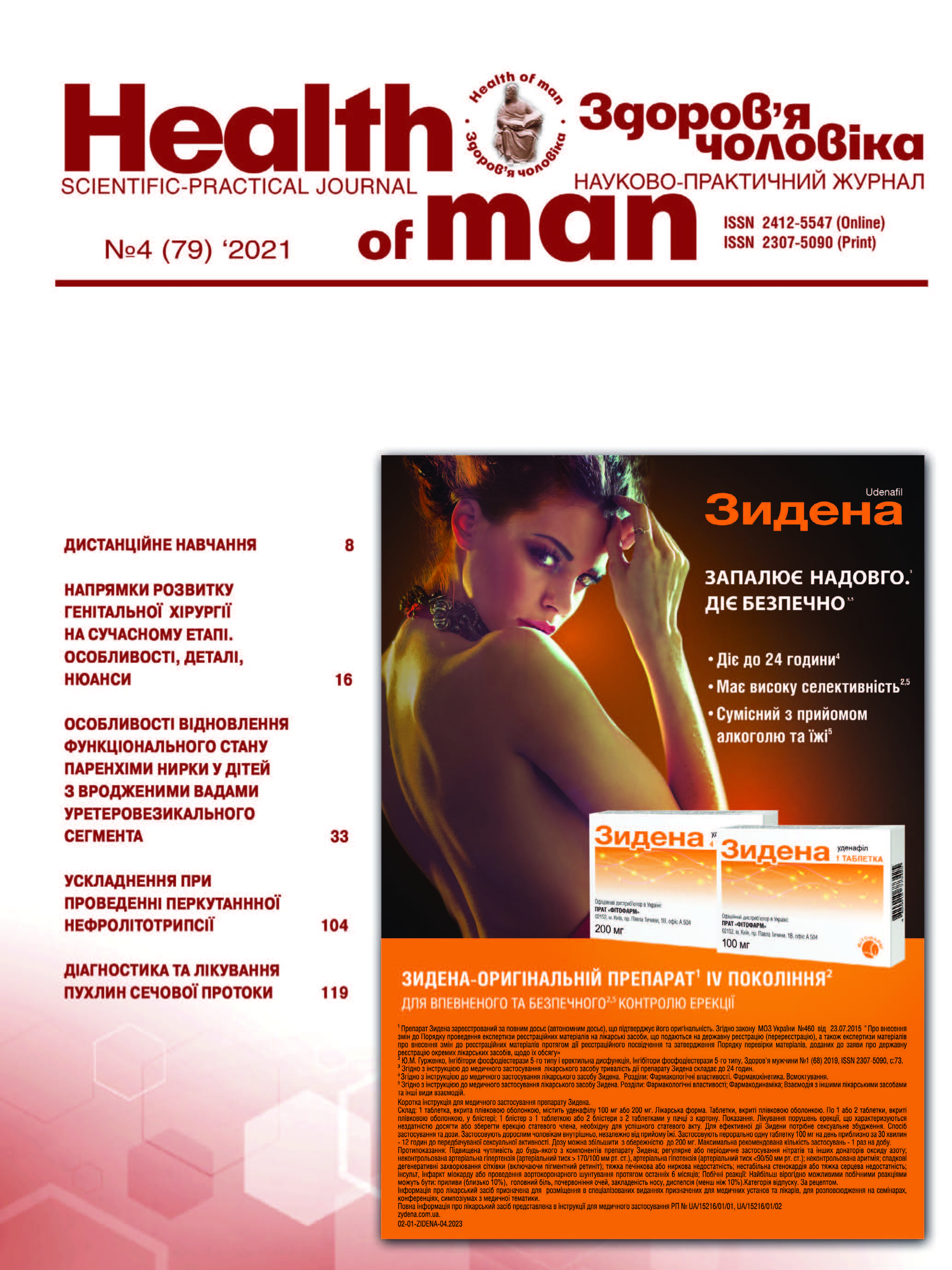Directions of Development of Modern Genital Surgery. Features, Details, Nuances
##plugins.themes.bootstrap3.article.main##
Abstract
The quality of life and self-esteem of a modern man are largely determined by the appearance and functional state of his genitals. The quite high demand for improving the morpho-functional properties of the penis is the driving force of progress in the field of penile surgery. Despite the positive meaning of the surgical arsenal diversity for meeting the needs of the patient, the latter puts additional requirements for standardization, safety assessment and development of algorithms for their selection. Under these circumstances, there is a significant need for publications that inform specialist with the practical aspects of external genital surgery in men.
The objective: to analyze modern algorithms for managing patients with various pathologies / defects of the penis (penile dysmorphophobia, erectile dysfunction, Peyronie’s disease, congenital deviation, priapism, cavernous fibrosis, trauma and tumors) and methods of their surgery.
Materials and methods. Bibliosemantic material that covers current aspects and trends of genital surgery over the past 10 years, and case reports of patients who applied to the Department of Sexopathology and Andrology of the Institute of Urology of the National Academy of Medical Sciences of Ukraine with penile pathology that required surgical correction.
Results. It is demonstrated that the algorithm of managing a patient with anatomical defects of the penis, should include: analysis and correction of deformation based on geometric principles; increase in size and / or elongation of the short side (small curvature); minimization of complications (loss of sensitivity, hematoma, necrosis); preservation or restoration of erectile function; restoration of the urethra (length and caliber), normalization of the urination, restoration of a full sexual life with adequate psychological adaptation.
It has been shown that severe erectile dysfunction, which is not amenable to therapeutic correction, requires the penile implantation. On the other hand, penile implantation is contraindicated in uncompensated diabetes mellitus, decompensation of the cardiovascular system, late-stage cancer, acute inflammatory processes of various localizations, mental illness, skin lesions of various etiologies in the area of the scrotum and penis, in patients with a high frequency of repeated endoscopic procedures, tissue defects in the area of operation with the predicted inability to stretch, hypersensitivity to silicone, the mismatch of the size of the corpora cavernosa to the size of the selected type of implant. It has been proven that ligamentotomy and corporoplasty prevent the loss of penis length after implantation, but increase the likelihood of complications.
Complications of penile implantation include: prosthesis-associated infection, erosions, migration or extrusion of the prosthesis, migration of proximal tips, mechanical failure of the prosthesis, tissue and / or allergic reaction, acute urinary retention, pain, hematoma, edema, edema and lymphoma intraoperative perforation of the urethra or corpora cavernosa. Clinical cases of certain complications and methods of their elimination are given. The choice of method of correction of penile deviation is determined by the state of erectile function, the length of the penis, the angle of curvature, the wishes of the patient. Grafting (short penis, angle of curvature> 60 °, presence of deformities) or plication (sufficient length of the penis, angle of curvature <60 °, no deformities) can be performed if erectile function or pharmacotherapy is preserved. At erectile dysfunction at condition of inefficiency of pharmacotherapy implantation is shown.
Conclusion. At the present stage, the main direction of movement in genital surgery is a combination of aesthetics and functionality. A specialist in penile surgery must have the skills of a urologist, andrologist, aesthetic surgeon and psychologist. In patients with penile dysmorphophobia, subjective assessment of the appearance of the genitals correlates with psychological status. The main psychological feature of a patient with penile dysmorphophobia is dissatisfaction with the size of the penis (length and / or thickness) at normal anatomical proportions. The modern arsenal of penile surgery is diverse and includes methods of correction of deviations / deformations, increase in size (length / thickness); axial rigidity, urethral capacity (length and caliber), during which implants can be used.
Penile surgery is associated with the risk of severe complications: loss of sensitivity of the penile glans, hematoma, necrosis, prosthetic infection, rupture of the the corpora cavernosa and urethra. Further research should determine optimal algorithms for selecting certain surgical techniques taking into account aesthetic, functional criteria and safety.
##plugins.themes.bootstrap3.article.details##

This work is licensed under a Creative Commons Attribution 4.0 International License.
Authors retain the copyright and grant the journal the first publication of original scientific articles under the Creative Commons Attribution 4.0 International License, which allows others to distribute work with acknowledgment of authorship and first publication in this journal.
References
Egydio PH, Kuehhas FE, Valenzuela RJ. Egidio PH. Modified Sliding Technique (MoST) for Penile Lengthening with Insertion of Inflatable Penile Prosthesis. J Sex Med. 2015;12(5):1100-4. doi: 10.1111/jsm.12911
Egydio PH, Kuehhas FE. The Multiple-Slit Technique (MUST) for Penile Length and Girth Restoration. J Sex Med. 2018;15(2):261-9. doi: 10.1016/j.jsxm.2017.11.223.
Yeager ME. Operating room manual: a guide for O.R. personnel. New York: G. P. Put-nam’s Sons; 1965. 313 p.
Langston JP, Garaffa G, Ralph D. Penile Reconstructive Surgery Using Grafts [Internet]. In: Muneer A, Pearce I, Ralph D, editors. Prosthetic Surgery in Urology. Springer, Cham. Available from: doi: 10.1007/978-3-319-13859-6_17.
Boeri L, Capogrosso P, Cocci A, Dimitropoulos K, Gül M, Hatzichristodoulou G. Sexual and Reproductive Health [Internet]. EAU Guidelines. European Association of Urology. Guidelines. Arnhem: European Association of Urology; 2020. 232 p. Available from: http://uroweb.org/guidelines/compilations-of-all-guidelines/.
Egydio PH. An Innovative Strategy for Non-Grafting Penile Enlargement. A Novel Paradigva for Tunica Expantion Procedures. J Sex Med. 2020;17(10):2093-103. doi: 10.1016/j.jsxm.2020.05.010.





